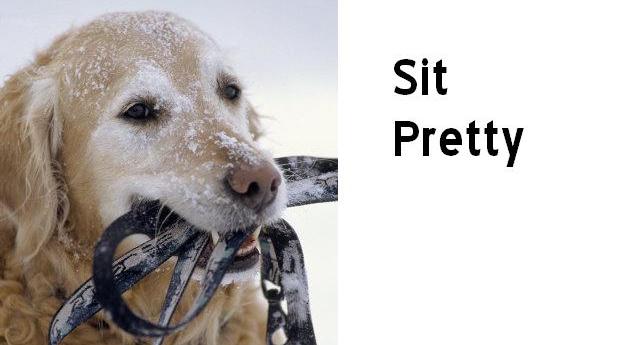F I R S T
S T E PHave dog at your left side in "heel position".
Take leash in right hand and put your left hand on dog's bum (right over his hips, above his tail).
Try to do the three following steps at the same time:
1. Say sit
2. Pull straight up on leash
3. Gently push down on the dog's bum
As soon as the dog's butt touches the floor, IMMEDIATELY praise and give him a treat.
With the above step, timing is everything. It's actually more difficult for the newbie trainer to learn than the dog.
If you do this correctly for a day or two, you will have a dog immediately dropping his butt to the floor with just the verbal command. That verbal command will even go away as you teach your dog cues with your body language. That is the goal you are working towards.
The things people do to mess up their dogs' sits:1. Jump ahead of the dog's ability
Meaning, they tell a beginner dog to sit and either stand around dopily when the dog doesn't sit, or they keep repeating the command.
If your dog does not immediately do what he is supposed to, go back a step or even go back to basics and reinforce.
2. They confuse the dog by giving mixed signals
This could be anything, but a good example is pulling forward at the leash (like you are urging the dog to move forward) instead of pulling straight up on the leash.
Be consistent. Know exactly what to do for each exercise and do it as precisely as possible.
3. They stress their dogs out
When dogs are stressed, that's when they start to tune their trainer out and they mentally go to a happier place.
Try to stay calm and pleasant when training your dog. If you must correct your dog, do so, but don't drag it out so your dog feels like training time is torture time.
4. They bore their dogs to death
Repetition is good, but most dogs (especially the young ones) have a short attention span. Most exercises should only be repeated 3-5 times in a training session. The trainer should mainly aim to end on a positive and GOOD note.
* * * * * * * * * * * * * * * * * * * * * * * * * * * * * * * * * * * * * * *
S E C O N D
S T E PDisclaimer: Most people only need the first step - particularly if they have no intention of doing show obedience. This step is geared towards people who want to compete.
If you are planning on showing your dog, you will not be allowed to give any commands in the show ring.
The judge will tell you and your dog to 'halt'. This means you stop moving and your dog is expected to immediately sit at your left side without ANY commands from you.
This causes a lot of panic for newbie trainers, because a lot of their dogs simply won't sit without the verbal or leash command.
The best thing to do is wean yourself off both crutches as soon as possible.
The steps are:
1. Teach sit (leash, bum, treat)
2. Wean off bum and leash command, rely only on treat and voice
Switch leash to the left hand, treat with the right hand.
3. Hide treat in pocket and give verbal command, reward successful sits with treat
These steps are taught while moving around around the room. Each time you come to a stop, you make the dog sit. And you must be consistent.
4. The dog will make the connection sooner or later that stopping means he has to sit, even when you do not give him the verbal command. When he does this right, he IMMEDIATELY gets the treat and praise.
* * * * * * * * * * * * * * * * * * * * * * * * * * * * * * * * * * *
T H I R D
S T E P This isn't exactly a step, but it comes after your dog knows and is getting pretty consistent with the sits.
That's when you start worrying about refining the sits themselves.
SpeedIn the show ring, the dog has to sit down immediately. If he hesitates before sitting or the sit motion is too slow, then the judge deducts points.
Maybe once a week, have a training session when you do rapid fire sits. You go back to basics (leash, bum, treat), but do them very fast.
A well-trained dog is not going to like getting the leash/bum correction and will learn to pay attention and drop his butt down as soon as you stop. When he does that throw a huge treat and praise party.
The important thing is to not ever bully or hurt your dog. Training is supposed to be fun. If you scare the heck out of your dog, that will definitely cause problems in the show ring. Keep in mind the dog's movement is supposed to be natural. If he shows fear in the ring, it means points off or it could disqualify you.
Heel position:Dog is at your left side with the front of his shoulders in line with your leg.
If you teach the sit wrong or if you are one of those people who unconsciously step into the dog - the dog will learn to swing his sit out. Instead of sitting face forward with his shoulders in line with your knee and the rest of his body a straight line, the dog might have a slightly crooked sit, or he might even turn completely so he facing you.
The easiest fix is to find a straight wall in your house to practice next to. Put your dog between you and the wall, give him enough room to sit but make it tight enough so he is forced to do straight sits, and work your way up.
Maybe do this once a week as a reinforcement, while ALSO working sits away from the wall the rest of the time. You do not want to start using the wall as a crutch.
* * * * * * * * * * * * * * * * * * * * * * * * * * * * * * * * * * *
H A N D
S I G N A L This is just a fun trick to teach your dog for around the house and to impress the family. There are also some times when you are in public and your dog is loose. Like say if you are talking to somebody and don't want to stop talking to either give your dog a verbal sit command or reach for him, just pointing a finger works.
You teach this trick after your dog has been taught and knows his sits (leash, bum, treat).
1. Stand in front of your dog. Dog should be standing at this point.
2 Use the index finger of your right hand (doesn't matter which hand, but make sure it's the same hand each time) to point directly over his head and tell your dog to sit.
3. As soon as he sits, give him treat and praise.
4. Wean off verbal commands and just point and reward.
If you have a distractive dog, you can always show him the treat and close it in your right hand. That will keep his attention on that hand when you raise it and point.
After the dog learns the hand signal, you can build distance. My dog can be on the other side of a big room and will sit as soon as he sees that pointing finger. Build distance gradually - like a foot at a time.
#Note on SitsIf your dog is slow to sit or doesn't like sitting, it might be just be stubborness (and God knows dogs can put on the stubborn face and fight an annoying bossy owner).
It could also be a back or hip problem making those sits painful or uncomfortable for him.
Know your dog and keep your eyes open for any developing health problems.
My old golden Danny (see my Welcome post) had really bad hips in his old age, and he would sit in slow motion when I asked him to. I still asked him to sit, because it kept his little mind busy in old age and training was always a positive play thing with us*, but I let him sit however as slow as he wanted. If he had bad days where his hips were really locking up and sore, I would not ask him for any sits.
*When I started training the current dog (Jacket), I'd have to lock Danny in his room (coincidentally, my bedroom), otherwise he'd come barging out and try to training right next to Jacket, if not
between me and the pup.



